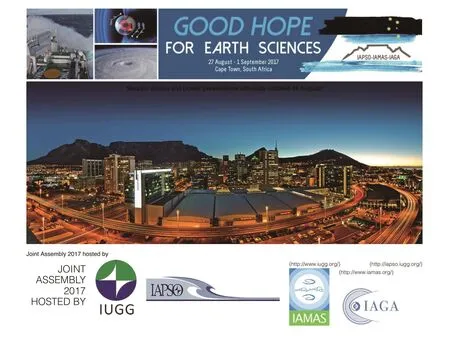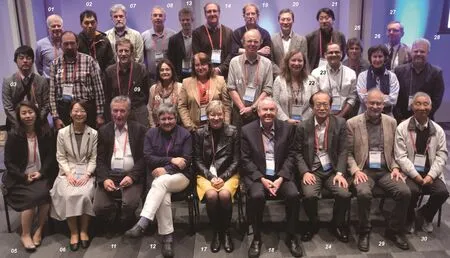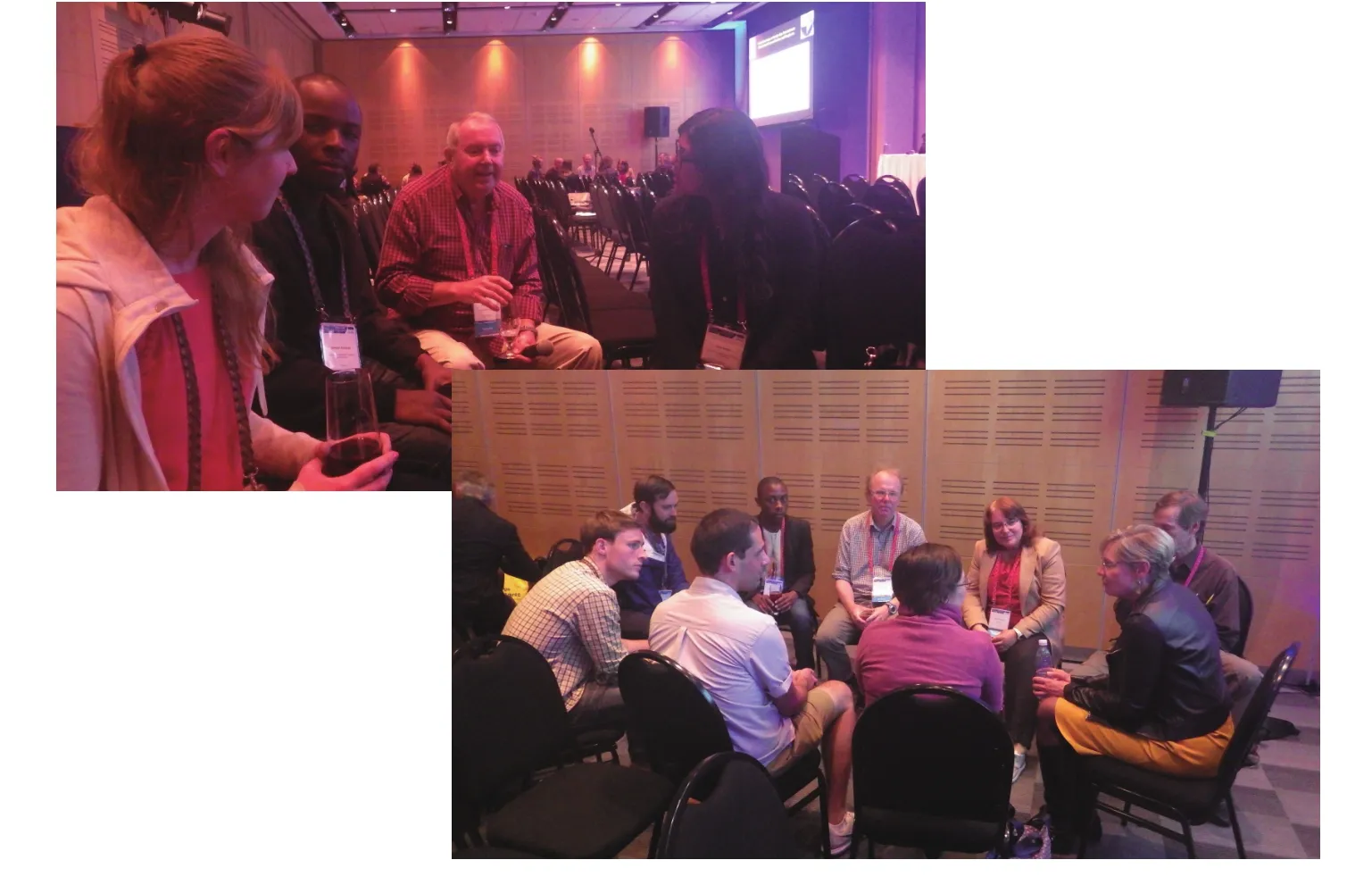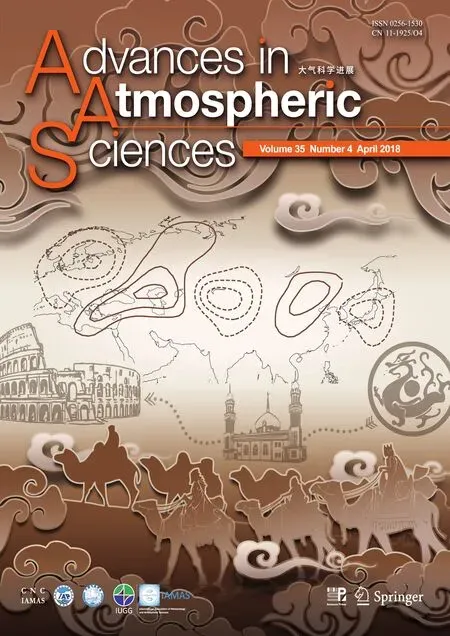Report on IAMAS Activity since 2015 and the IAPSO-IAMAS-IAGA Scientific Assembly—Good Hope for Earth Sciences
John TURNERand Teruyuki NAKAJIMABritish Antarctic Survey,High Cross,Madingley Road,Cambridge,CB3 0ET,United Kingdom
2Japan Aerospace Exploration Agency,2-1-1 Sengen,Tsukuba,Ibaraki 305-8505,Japan
Three associations of the International Union of Geodesy and Geophysics(IUGG)—International Association for the Physical Sciences of the Oceans(IAPSO),International Association of Meteorology and Atmospheric Sciences(IAMAS)and International Association of Geomagnetism and Aeronomy(IAGA)—held their joint Scientific Assembly over 27 August–1 September in Cape Town,South Africa.This was the first full IAMAS assembly to be held in Africa(Figs.1&2).The IAMAS-registered participants constituted 36%of the total attendees of more than 1000 scientists from 64 countries.IAMAS supported the registration fee/accommodation of 21 young scientists and scientists from developing countries.We gratefully express our warm thanks to the Local Organizing Committee(Chair,Prof.Isabelle ANSORGE)and the Scientific Programme Committee,and all others for making the scientific assembly a great success in the beautiful city of Cape Town.
This assembly was an effective platform for discussion and planning of cross association science with 11 joint symposia being held by IAMAS,IAPSO and IAGA.The four IAMAS-led symposia were:
JM1—Observing Our Planet from Space(IAMAS,IAGA,IAPSO)
JM2—Climate Variability and Change on all Scales(IAMAS,IAPSO)
JM3—Thunderstorm Coupling to the Upper Atmosphere(IAMAS,IAGA)
JM4—Future Climate for the African Continent(IAMAS,IAPSO)
At the same time,IAMAS promoted their own science through IAMAS-only symposia:
M01—Atmospheric Chemistry and Physics for the 21st Century
M04—Past Climate Changes:A key for the Future
M05—Aerosol–cloud Session
M08—Advances in Atmospheric Dynamics
M09/M19—Dynamics of Mountain Weather and Climate:Observations,Modeling and Prediction at all Scales/Precipitation at all Scales
M10—Tropical Circulation Systems
M11—The Seasonal Cycle over the African Continent and Adjoining Oceans,Today and in the Past
M12—Middle Atmosphere Symposium
M14—Vertical Atmospheric Coupling the Polar Atmosphere
M15—Energy balance of the Earth
M16—Resilience:The science of Adapting to Climate Change
M17—High-impact Weather and Climate Extremes
M18—Advances and Frontier challenges in Global Monsoon Studies
M20—Role of Ocean-Atmosphere Interactions in Climate Variability,Change and Predictability
M22—Sub-seasonal to Seasonal Prediction–except extremes
During the opening ceremony,the IAMAS keynote speaker,Prof.Mary SCHOLES,University of the Witwatersrand,South Africa,stressed the importance of study of the impact of nitrogen and sulphur cycles on the terrestrial system in Southern Africa and sustainable development.

Fig.1.A snapshot of the web page of the IAPSO-IAMAS-IAGA Scientific Assembly 2017 in Cape Town—Good Hope For Earth Sciences.

Fig.2.IAMAS Executive Committee members and National Delegates.
The Cape Town assembly was a great opportunity for the IAMAS community to meet together,especially in the IAMAS plenary session held on 31 August.John TURNER,the President of IAMAS,gave an overview of IAMAS activities since IUGG 2015,which was followed by a panel discussion.The president highlighted the great success of the 2015 IUGG assembly in Prague, the eight major goals of the IUGG Strate-gic Plan,the establishment of an IAMAS Facebook page(https://www.facebook.com/groups/894638217243596/?fref=ts),the focus on trying to engage with early career scientists involved with the atmospheric sciences,the membership of the IAMAS President on the Executive of SCOR,the success of the relationship between IAMAS and the journal Advances in Atmospheric Sciences,and others topical issues.The panel discussion confirmed the active role of the IAMAS commissionscIAMAS has ten International Commissions on 10 Scientific topics on Atmospheric Chemistry and Global Pollution(ICACGP),Atmospheric Electricity(ICAE),Climate(ICCL),Clouds and Precipitation(ICCP),Dynamic Meteorology(ICDM),Meteorology of the Middle Atmosphere(ICMA),Planetary Atmospheres and their Evolution(ICPAE),Polar Meteorology(ICPM),Ozone(IO3C),Radiation(IRC),and Nucleation and Atmospheric Aerosols(CNAA).in promoting the atmospheric sciences and encouraging early career scientist initiatives such as Young Earth System Scientist(YESS)and the Association of Polar Early Career Scientists(APECS).But,at the same time,we agreed on some desirable priorities for our assemblies,such as more lectures by outstanding scientists reflecting the progress in our science,a child policy for scientists with children who attend the assembly,an active accompanying person’s programme,archiving and broadcasting of lectures and presentations,and further development of IAMAS information dissemination to raise the profile of our association.Another highlight of the plenary session was the presentation of the 2017 IAMAS Early Career Scientist Medal to Corinna HOOSE(Karlsruhe Institute of Technology,Germany).The citation was read out by IAMAS Vice-President Prof.Joyce PENNER,the chair of the Awards Committee.Dr.HOOSE’s research has been concerned with modeling of mixed-phase clouds on different scales,with a focus on the parameterization of heterogeneous ice nucleation (e.g., Hoose andM¨ohler,2012).
An IAMAS Early Career Scientist event was held in the evening of 31 August with about 20 young scientists attending(Fig.3).Julia Keller discussed the YESS organization,which now has 1000 members in 83 countries.They held a workshop in 2015,have organized monthly teleconferences since 2015 and held a webinar series on earth science.They published an article in the Bulletin of the American Meteorological Society in 2017 to report their activities(Rauser et al.,2017).It was noted that the number of PhD candidates is decreasing in Japan,whereas it is increasing in Germany.Marius W.ROSSOUW reported on the activities of APECS South Africa.APECS,which was established in 2007,now has 7500 members worldwide from 101 countries.They publish a monthly newsletter to promote their activities.Corinna HOOSE gave a presentation on her career development.The presentation was useful for students and other young scientists and focused on how to keep their motivation during diffi cult periods in their research career and private life.Participants asked various questions and gave ideas regarding IAMAS activities and how to be more involved with the organization.A highlight of the event was a“speed networking session”.This involved the early career scientists rotating between four groups consisting of IAMAS officers,senior scientists,YESS/APECS officers and scientists transitioning between the early and mid-career stages.
The IUGG 2015 and IAMAS 2017 assemblies were important events for the IAMAS community,butthe Bureau and commissionscIAMAS has ten International Commissions on 10 Scientific topics on Atmospheric Chemistry and Global Pollution(ICACGP),Atmospheric Electricity(ICAE),Climate(ICCL),Clouds and Precipitation(ICCP),Dynamic Meteorology(ICDM),Meteorology of the Middle Atmosphere(ICMA),Planetary Atmospheres and their Evolution(ICPAE),Polar Meteorology(ICPM),Ozone(IO3C),Radiation(IRC),and Nucleation and Atmospheric Aerosols(CNAA).have been working constantly on dealing with day-to-day issues concerned with the association,and links to the science community and society.Some of these activities have been published in reports(Colwell et al.,2016;Edkins et al.,2016;Godin-Beekmann et al.,2017;Moffat-Griffin et al.,2017;Volkert,2017).
IUGG and IAMAS have 59 regular and 10 associate National Members.The names of IUGG and IAMAS National Correspondents(NCs)are given on the IUGG web site(http://www.iugg.org/members/adhering.php).Recently,Italy initiated a national scheme for meteorologists and meteorological technicians compliant with WMO 1083(WMO,2012).It should be noted that a common question raised by the IAMAS 2017 participants was how to find the name of their NC,indicating that there is a need for increased dissemination of the NC information and improved communication and interaction with NCs.
Over the last two years,IUGG and IAMAS supported the following Scientific conferences organized by the IAMAS commissions:
?International Radiation Symposium 2016,Auckland,New Zealand,17–22 April 2016
?XVII International Conference on Clouds and Precipitation(ICCP)Manchester,UK,25–29 July 2016
? Ninth International Cloud Modelling Workshop(ICCP),Exeter,UK,18–22 July 2016
? ICDM Blocking workshop,Reading,UK,6–8 April 2016
? 6th International HEPPA-SOLARIS Workshop(ICMA),Helsinki,Finland,13–17 June 2016
?SPARC workshop on Stratospheric Change and its Role for Climate Prediction(SHARP)(ICMA),Berlin,Germany,16–19 February 2016
?Eleventh Antarctic Meteorological Observation,Modeling and Forecasting Workshop(AMOMFW)(ICPM),Columbus,USA,6–8 June 2016
? ANtartic Gravity Wave Instruments Network(ANGWIN)3rd workshop(with ICSU SCAR),Cambridge,UK,12–14 April 2016
?The International Venus Conference(ICPAE),Oxford,UK,4–8 April 2016
?iCACGP Scientific Steering Committee meeting,Boulder,USA,22–23 September 2016
?The International Ozone Commission Quadrennial Ozone Symposium(IO3C),Edinburgh,UK,4–9 September 2016
?Workshop on trends and long term variations in the middle and upper atmosphere(with IAGA),19–23 September 2016
?CCEC2016(with IUGG the Union Commission on Climatic and Environmental Change),Luxembourg,24–25 October 2016

Fig.3.IAMAS early career scientist event on 31 August.
?The Batsheva de Rothschild Seminar on The Atmospheric Global Electric Circuit(GEC),Israel,5–10 February 2017
?Climate Extremes and the Global Energy and Water Cycle:Improving and Integrating Knowledge Across Disciplines,Global Soil Wetness Project(GSWP),The Inter-Sectoral Impact Model Intercomparison Project(ISI-MIP)&Hydrology delivers Earth System Sciences to Society(HESSS4)Joint Workshop(ICCL),Tokyo,Japan,16–19 May 2017
?Twelfth Workshop on Antarctic Meteorology and Climate(ICPM),Boulder,USA,26–28 June 2017
?iCACGP Annual Meeting(iCACGP),Cape Town,South Africa,26–27 August 2017
?Third Atmospheric Composition and the Asian Monsoon(ACAM)Workshop(iCACGP),Guangzhou,China,5–9 June 2017
?Aerosol Training School as part of the Caribbean Aerosol-Health Network(iCACGP),Camaguey,Cuba,January 2018
?Training Workshop on Processing of Cloud Particle Measurements(ICCP),Oberpfaffenhofen,Germany,7–9 July 2017
?LOTUS(Long-term Ozone Trends and Uncertainties in the Stratosphere)Workshop(IO3C),Paris,France,13–15 March 2017
?Twentieth International Conference on Nucleation and Atmospheric Aerosols(ICCP&CNAA),Helsinki,Finland,30 June–2 July 2017
IUGG and IAMAS also supported two training schools,“Training school on stratosphere-troposphere interactions”on the occasion of ICMA-IAMAS-IAPSO 2017 Assembly by the ICMA commission and“ACAM Training school for students and early career atmospheric scientists from Asian monsoon countries”in June 2017 by the ICACGP commission.
The period since 2015 also had other important issues to be managed by IAMAS.A letter was sent to the Australian Government on the possible cutback of CSIRO staff and grant cessation of climate-related bodies(June 2016).We had a response from Greg HUNT,Ministry for Industry,Innovation and Science(30 Sept 2016).The IUGG Bureau statement was issued on US Government withdrawal from the Paris Agreement(12 June 2017).
The IUGG Strategic Plan 2016–2023 was published in December 2016 and identified eight major goals of the organization.These are to:
1)Promote IUGG to its constituents,and to geoscientists,policy-makers and to society in general
2)Encourage closer cooperation between the IUGG groups
3)Encourage more effective engagement with sister organisations,and other partner agencies
4)Assist under-represented geoscientists to more fully participate in international science activities
5)Strengthen the effectiveness of its Council,EC and Bureau
6)Strengthen National Committees
7)Promote fundamental research and education in the geosciences
8)Encourage countries to become a member of the IUGG
The merger of ICSU and ISSC(International Social Science Council)was agreed in November 2016.The merger has been supported in light of new initiatives,such as Future Earth,which needs an enhanced collaboration between natural and social sciences.But,there are various concerns regarding the differences in the two organisations,so that there needs to be more discussion to make it effective in the implementation phase.A scoping workshop for the design and development of a Help Desk for the Global Framework on Climate Services(GFCS)took place in June 2017.IAMAS will help through the provision of scientific knowledge.
We will enter the second half of the present term between General Assemblies(2015–2019)preparing for the next General Assembly in Montreal,Canada in 2019.IUGG and IAMAS will both be 100 years old in 2019(Shaw,1923)and are planning special events to be held at the 2019 IUGG assembly in Montreal.Contributing to the IUGG Task Force for the centennial event(TF100)is important and various events are being organised as follows:
?Early Career Earth and Space Scientists event
?Publication of a monograph on IUGG’s history
?IAMAS side conferences and medal award events
?Joint symposia with other associations
Beyond it is the next IAMAS Scientific Assembly to be held in 2021.The venue has just been determined as Busan,South Korea,with the decision made by the IAMAS Executive Committee.This Scientific Assembly will be a joint event between IAMAS,IAPSO,and IACS.This will offer an opportunity to explore new science in the atmosphere,ocean and cryosphere and their interactions.
Colwell,S.R.,A.M.Cayette,M.A.Lazzara,J.G.Powers,D.H.Bromwich,J.J.Cassano,and S.Carpentier,2016:The 10th Antarctic meteorological observation,modeling,and forecasting workshop.Adv.Atmos.Sci.,33,656–658,https://doi.org/10.1007/s00376-016-6012-3.
Edkins,N.,W.Schmutz,L.Egli,R.Davies,T.Aoki,and G.Mcfarquhar,2016:The international radiation symposium 2016.Adv.Atmos.Sci.,33,1325–1328,https://doi.org/10.1007/s00376-016-6180-1.
Godin-Beekmann,S.,and Coauthors,2017:The quadrennial ozone symposium 2016.Adv.Atmos.Sci.,34,283–288,https://doi.org/10.1007/s00376-016-6309-2.6.
Hoose,C.,and O.M?hler,2012:Heterogeneous ice nucleation on atmospheric aerosols:A review of results from laboratory experiments.Atmospheric Chemistry and Physics,12,9817–9854,https://doi.org/10.5194/acp-12-9817-2012.
Moffat-Griffin,T.,M.J.Taylor,T.Nakamura,A.J.Kavanagh,J.S.Hosking,and A.Orr,2017:3rd ANtarctic Gravity Wave Instrument Network(ANGWIN)science workshop.Adv.Atmos.Sci.,34,1–3,https://doi.org/10.1007/s00376-016-6197-5.
Rauser,F.,and Coauthors,2017:Earth system science frontiers:An early career perspective.Bull.Amer.Meteor.Soc.,98,1120–1127,https://doi.org/10.1175/BAMS-D-16-0025.1.
Shaw,S.N.,1923:The meteorological section of the international geodetic and geophysical union.Quart.J.Roy.Meteor.Soc.,49,23–34,https://doi.org/10.1002/qj.49704920507.
Volkert,H.,2017:Putting faces to names:Snapshots of two committee meetings,95 years apart,emphasize continuous international cooperation in the atmospheric sciences.Adv.Atmos.Sci.,34,571–575,https://doi.org/10.1007/s00376-017-6329-6.
WMO,2012:Manual on the Implementation of Education and Training Standards in Meteorology and Hydrology.Volume 1-Meteorology.World Meteorological Organization,WMONo.1083.
 Advances in Atmospheric Sciences2018年4期
Advances in Atmospheric Sciences2018年4期
- Advances in Atmospheric Sciences的其它文章
- Asymmetric Relationship between the Meridional Displacement of the Asian Westerly Jet and the Silk Road Pattern
- Impact of SST Anomaly Events over the Kuroshio–Oyashio Extension on the “Summer Prediction Barrier”
- Idealized Experiments for Optimizing Model Parameters Using a 4D-Variational Method in an Intermediate Coupled Model of ENSO
- Variations in High-frequency Oscillations of Tropical Cyclones over the Western North Pacific
- Large-scale Circulation Control of the Occurrence of Low-level Turbulence at Hong Kong International Airport
- Evaluating the Capabilities of Soil Enthalpy,Soil Moisture and Soil Temperature in Predicting Seasonal Precipitation
